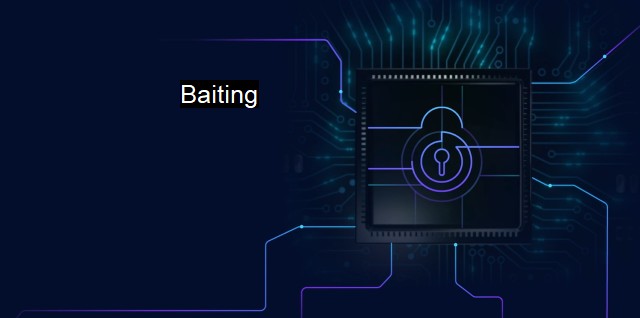What is Baiting?
Exploring the World of Cybersecurity: Uncovering the Traps of Baiting and How Hackers Use Human Psychology to Plant Malware
Baiting is a specific form of social engineering attack that exploits the human tendency of curiosity or greed to initiate a malicious activity. the term is familiar and associated more popularly with cybercriminals aiming to penetrate the security measures of networks and systems. Baiting, just like phishing and pretexting, is a strategy hackers use to trick users into revealing their sensitive information, enabling malware installation, or opening a system for misuse.For understanding how baiting works, one needs to realize that this tactic involves a promise. This promise usually leads curiousity-driven users to click a link, downloading a file, or complete some sort of action that they wouldn't do otherwise, all while assuming that the action would benefit them.
Baiting may come in different forms and settings. It can be as simple as a scamming email promising lottery win or a fake online ad enticing users with free movie downloads or click-bait articles. One of the most common forms of baiting occurs when cyber attackers drop USB drives loaded with malware, often with tempting labels such as "Salary List" or "Confidential", in a place where potential victims find them. Out of curiosity, if the drive is inserted to access the information, the victim's machine can become infected.
These malicious forms of baiting are designed to trigger malware installations or authorize malicious access. An effective bait convinces the users that they are, in fact, contemplating a harmless action, hidden behind which is an attacker's script running to accomplish the attacker's goals.
When discussing baiting within the narrative of antivirus software and cybersecurity, the same concept of baiting is applied, albeit a legitimate version. Security developers and cyber experts have developed strategies called "honeypots" and "honeynets" to catch cybercriminals. These traps, in the form of appealing but fictitious network vulnerabilities, are baited to attract potential attackers. When intruders take the bait and infiltrate the non-essential mock-up system, the cyber experts can learn about their methods, tools and attack patterns to provide valuable data for prevention and strengthen security measures in the real network environment.
Despite being a clever countermeasure, the pivotal area in the battle against baiting still is user awareness and behavior. Cybersecurity measures could be put in place, firewalls and latest antivirus systems could be installed, yet the cautiousness of a single click or action by an informed user could easily surpass these defences in efficacy.
Being suspicious of too-good-to-be-true offers, verifying the sender or website before revealing sensitive information, installing reliable antivirus software and keeping them updated, restricting download from untrusted sources, these are some of the proactive measures a user can take in this supposed context of cybersecurity.
Ensuring adequate security education and training for those with access to any network system can significantly mitigate the risks posed by baiting. Adaptation of multi-level authentication, timely and regular software updates, strong and unique passwords further solidify the cybersecurity posture of an organization or an individual against the deceptions of baiting techniques.
Though baiting is an affliction on cybersecurity and imposes challenges on antivirus strategies mainly due to human vulnerabilities, it certainly isn’t invincible. With the right level of caution, updated software programs, and robust cyber hygiene habits, one can successfully avoid falling into a baiting trap. Expert precautions like honeypots and honeynets also provide a powerful defence against attackers. the baiting tactic is a potent reminder of the importance of the human factor defining the margin between secure and compromised space.

Baiting FAQs
What is baiting in cybersecurity?
Baiting is a social engineering technique that involves tempting a victim with a fake or malicious file or link. The goal of this technique is to compromise the target's system or steal sensitive information.How does baiting work?
Baiting involves offering a user something they want or need, such as a free software download or a discount code, but with a catch. The baited item contains malware, spyware, or other malicious code that infects the user's computer once downloaded or clicked upon.How can I protect myself against baiting attacks?
To protect yourself against baiting attacks, be cautious about downloading any files, especially from unknown sources. Use reliable antivirus software that can detect and block malicious downloads. Also, avoid clicking on links or attachments in emails from unknown senders.Can businesses be targeted by baiting attacks?
Yes, businesses can be targeted by baiting attacks, especially if their employees are not properly trained to recognize and avoid such attacks. Baiting attacks can lead to severe consequences, such as data breaches or financial losses. That's why it's important for businesses to provide regular security awareness training to their employees.| | A | | | B | | | C | | | D | | | E | | | F | | | G | | | H | | | I | | | J | | | K | | | L | | | M | |
| | N | | | O | | | P | | | Q | | | R | | | S | | | T | | | U | | | V | | | W | | | X | | | Y | | | Z | |
| | 1 | | | 2 | | | 3 | | | 4 | | | 7 | | | 8 | | |||||||